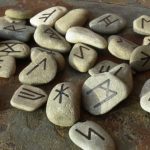 Mysteries
Mysteries  Mysteries
Mysteries  History
History 10 Surprising Stories About the Texas Rangers
 Humans
Humans 10 Philosophers Who Were Driven Mad by Their Own Theories
 Miscellaneous
Miscellaneous 10 Video-Game-Worthy Weapons and Armors from History
 Weird Stuff
Weird Stuff 10 Psychics Who Accurately Predicted Wartime Events
 The Arts
The Arts 10 Pieces of Art Inspired by a Broken Heart
 Health
Health 10 Science Fiction-Sounding New Medical Treatments
 History
History 10 Surprising Facts About the Father of Submarine Warfare
 Space
Space Ten Astonishing New Insights into Alien Worlds
 Weird Stuff
Weird Stuff 10 Bizarre Summer Solstice Rituals Still Practiced Today
 Mysteries
Mysteries Top 10 Haunting Facts About the Ghost Ship MV Alta
 History
History 10 Surprising Stories About the Texas Rangers
 Humans
Humans 10 Philosophers Who Were Driven Mad by Their Own Theories
Who's Behind Listverse?

Jamie Frater
Head Editor
Jamie founded Listverse due to an insatiable desire to share fascinating, obscure, and bizarre facts. He has been a guest speaker on numerous national radio and television stations and is a five time published author.
More About Us Miscellaneous
Miscellaneous 10 Video-Game-Worthy Weapons and Armors from History
 Weird Stuff
Weird Stuff 10 Psychics Who Accurately Predicted Wartime Events
 The Arts
The Arts 10 Pieces of Art Inspired by a Broken Heart
 Health
Health 10 Science Fiction-Sounding New Medical Treatments
 History
History 10 Surprising Facts About the Father of Submarine Warfare
 Space
Space Ten Astonishing New Insights into Alien Worlds
 Weird Stuff
Weird Stuff 10 Bizarre Summer Solstice Rituals Still Practiced Today
10 Mind-Altering Substances Used Centuries Ago
The ability to change one’s mental state has appealed to humans throughout history. Thanks to nature, people around the world have almost always found ways to do it. Some of the methods in this list have been lost entirely, but others are still used today for recreation or even as medicine. Some of them you might even have at home. Well-known examples that have been refined into modern, more potent means of mind alteration, like opium and the coca leaf, will not be mentioned here. What follows are ten lesser-known hallucinogens, sedatives, and stimulants used by historical societies around the globe.
Related: Top 10 Crazy Things Police Mistook For Drugs
10 Ergot
Ergot is a plant disease that infects grain crops. If it is consumed by humans, it infects them with a condition known as ergotism, which can be deadly. Its symptoms include hallucinations, delusions, muscle spasms, and seizures, depending on the dose. The connection between ergot and its symptoms went unnoticed until a couple of centuries ago, but it could explain several mass delusion and mass hysteria events from history.
Some experts believe that ergot caused participants’ visions during the Eleusinian Mysteries initiation ritual in ancient Greece. The drink kykeon could have contained infected rye. Ergot is also thought to have caused the “Great Fear,” which led to the French Revolution when peasants became scared that their crops would be stolen and rose up against their overlords. It might have caused witch hunts, and it is known to have taken entire armies out of action. In the 1930s, the scientist Albert Hofmann was studying ergot’s effects when he invented another influential substance: LSD.[1]
9 Silphium
It is hard to overstate the importance of silphium in ancient Greece and Rome. Its small flowers appeared on Greek money, the Romans wrote about it in songs and poems, and Julius Caesar stockpiled it alongside gold in the official treasury. So, what was special about it? It had an extraordinarily wide range of uses.
In medicine, it was something of a miracle herb, prescribed for all kinds of ailments. Its stalks and roots were eaten as vegetables, its sap was used as seasoning, it could preserve other foods, and perfume was made from its flowers. But silphium is probably best known for serving two further purposes in ancient bedrooms. Firstly, it was a well-known and potent aphrodisiac. And secondly, it may have been an effective form of birth control.
Because of its link with passion and sexuality, it has been theorized that the shape of silphium seeds is the origin of the love-heart shape used today. Its importance in those early civilizations makes it all the more bizarre that silphium disappeared along with them. The Roman historian Pliny reported that only one stalk was ever found in his lifetime, and it was given to Emperor Nero in the first century AD.[2]
8 Jimsonweed
Also known as thornapple, this weed made headlines in late 2022 when batches of baby spinach in Australia became contaminated with it. The public reported symptoms including blurred vision, abdominal cramps, and what were described as “quite significant” hallucinations. These symptoms should not come as a surprise; the weed’s toxic effects have been known for a long time. Like ergot, jimsonweed contains alkaloids. Some of them are toxic and can block neurotransmitters, which help the nervous system function properly. This can cause delirium, agitation, restlessness, and confusion.
In the 1600s, a unit of British soldiers in Virginia is believed to have eaten a meal containing the plant. They became incapacitated and stripped themselves naked. Some were said to be kissing their companions. The plant was given a new name after this: devil’s snare. But it is not all bad. The plant has been used in cosmetics and medical treatments, too.[3]
7 Mandrake
Harry Potter fans might remember a plant called devil’s snare, although it is nothing like the real thing. Mandrakes are another real plant species to appear in the wizarding world. They do not really let out a deafening scream like the fictional ones, but this was believed by people in the Middle Ages. People used to advise covering one’s ears and letting a dog pull the plant’s human-shaped roots out of the soil.
Unlike other members of the nightshade family—tomatoes, peppers, and potatoes—mandrakes are strongly hallucinogenic and have been used for this purpose for millennia. They have also been used as a painkiller, aphrodisiac, and fertility drug. Consumers can experience dizziness, increased heart rate, and disturbed vision and cognition at low doses, while high doses can be fatal. The toxicity of mandrakes also made people skeptical of related species like potatoes and tomatoes for quite some time.[4]
6 Henbane
Henbane is another member of the nightshade family. Like its relatives, it contains a mixture of alkaloids, which means it can be used medicinally, recreationally, or nefariously. Henbane has historically been used as a popular painkiller to treat conditions including earaches, rheumatism, and sciatica. It is still used in some parts of the world to ease toothache. As a poison, it was added to arrows and javelins by the Greeks and Gauls. Henbane is also the substance used by Claudius to murder Hamlet’s father in Shakespeare’s play.
As a hallucinogen, it earned a reputation in ancient Greece as a sacred “plant of Apollo.” This was because it was mixed with other herbs as part of rituals to induce a trance-like state said to allow people to commune with the gods. Henbane was also a key ingredient in “Witches Herb,” an ointment popular in the Middle Ages that caused people to hallucinate that they were flying. The association of witches and broomsticks is theorized to have originated from the use of the ointment.[5]
5 Nutmeg
This spice originated in Indonesia but has been consumed and traded worldwide for centuries. In fact, it used to be one of the most important spices ever traded. The Dutch East India Company certainly seemed to think so. They were so eager to monopolize it that they enslaved the populations of the islands where it grew, banned the export of the trees and fertile seeds, and punished those who attempted to grow nutmeg elsewhere with the death penalty. They also gave a less-important island on the other side of the world to the British in exchange for the last nutmeg-producing island. The island they gave up was Manhattan.
So, why was nutmeg so coveted? Like other substances on this list, it had medicinal uses. For example, people in the Middle Ages believed it could ward off the bubonic plague. But its popularity and price really surged later when it became fashionable among the wealthy. As well as being delicious, nutmeg contains myristicin, a compound that can have mind-altering effects, including hallucinations and change of mood if ingested in large enough doses. Some people still try to use nutmeg for this purpose today, although the doses required to achieve it come with other nasty side effects.[6]
4 Wormwood
Wormwood is known today as an ingredient of absinthe. The drink was invented in the 19th century when French soldiers in Algeria were given wormwood to help soothe fevers, prevent dysentery, and repel insects. They soon learned that adding it to their wine increased the punch and made it taste better. When they went back to France, they brought their new drink with them. It became a favorite among artists, and word spread that it had hallucinogenic effects. This increased the demand for it from some people but prompted others to protest against it.
While the drink has a relatively short history, wormwood does not. It was used medicinally for centuries. The name “absinthe” comes from an ancient Greek medicine called absinthion, which was also made by soaking wormwood leaves in wine. Wormwood wine and crème d’absinthe were also used recreationally.
Modern studies suggest that a compound in wormwood called thujone is responsible for its hallucinogenic effects. Thujone has a similar molecular geometry to THC, the active ingredient in cannabis. Thujone has some effect on cannabinoid receptors in the brain, but it does not evoke the same responses as THC.[7]
3 Joint Pine
In 1995, tubes containing 3,000-year-old human hair were discovered in a cave on the Spanish island of Menorca. Scientists studied chemical signatures in the hair to learn more about ancient societies in Europe. In 2023, they published the first direct evidence that European people were using hallucinogenic drugs 3,000 years ago. They know this because they found the alkaloids atropine, scopolamine, and ephedrine in the hair. The former two could have come from the consumption of nightshade plants such as mandrake or henbane. These may have been used as part of ancient rituals.
However, the ephedrine is likely to have come from another plant, known as joint pine. It is a stimulant that may have been consumed alongside the other plants to control or cause physical effects while hallucinating. The structure of ephedrine is similar to amphetamine, and it affects the sympathetic nervous system, which controls the body’s fight or flight response. This can cause an increase in heart rate and blood pressure, tremors, palpitations, restlessness, anxiety, and insomnia.[8]
2 Ethylene Gas
When the ancient Greeks had a question about the future, they went to see the oracle at Delphi. There, they would ask the Pythia—the female medium through which the god Apollo spoke–their question. She would enter a trance-like state as she interceded with the gods. The historian Plutarch, himself a priest at the Temple of Apollo, recorded that vapors were responsible for the Pythia’s behavior. Modern geologists discovered two fault lines actually intersect directly below the Delphic temple.
The rock in these places is permeable and contains passages that allow gases to rise. This can happen when hydrocarbon deposits stored in the rock are vaporized during earthquakes. The gases mix with groundwater and emerge around springs. Among the hydrocarbon gases analyzed by scientists near the Delphi temple was ethylene, a sweet-smelling gas that, if inhaled, can cause feelings of floating or disembodied euphoria. The Pythia was said to formulate her predictions in an enclosed chamber at the bottom of the temple. Being exposed to ethylene gas in a small, confined space may explain the trance-like state into which the Pythia fell.[9]
1 Salvia
Ritually consumed for centuries, this Mexican plant can be used to treat people who are addicted to other drugs. Salvia—nicknamed “divine sage”—is mainly used by the Mazatec people of southern Mexico. Their rituals draw from Catholic and ancient beliefs, and they can include the use of other psychoactive substances, such as psilocybin. Salvia is said to be healing when it is consumed with the right circumstances and preparation.
The Mazatec make their patients stick to a strict diet and abstain from sex, alcohol, and certain foods for several weeks before taking it. They claim it can help treat alcohol and cocaine addiction, and science has started to show that this might just be true. Salvia changes the brain’s level of dopamine, which controls motivation and reward.
While a stimulant like cocaine floods the brain with dopamine and causes a feeling of euphoria, salvia turns it down and causes dysphoria. This can result in people feeling detached from their bodies. It is no surprise the effects should be this strong; salvia contains salvinorin-A, the most potent naturally occurring psychedelic substance.[10]








